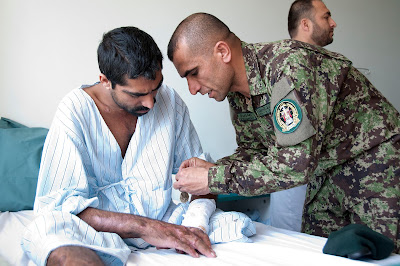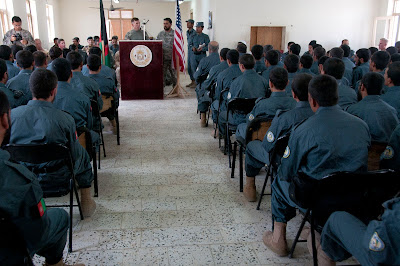Today, I had a visible reminder that while the wounded U.S. and coalition forces are the more visible casualties of the fight in Afghanistan, there are others who are fighting for and dying for this country – the Afghans themselves. On our way to visit wounded Afghan soldiers at the National Military Hospital in Kabul, our convoy was halted by a funeral procession. I looked out the window and saw a huge crowd of people – mostly in military uniform, so I knew it was a funeral for a fallen Afghan National Army soldier.

Although little publicized, especially to the American public, the Afghans are joining their armed forces - the Afghan National Army and Afghan Uniform Police - in droves. In a little less than a year, the army has grown almost 40,000 soldiers and the police by more than 20,000. Motivated by the need for a peaceful and stable country, these men and women are risking their lives to protect their country, fight corruption, drug lords and the Taliban who are doing their best to pull this country down.

Wounded soldiers are stabilized at the nearest regional hospital, located in Kandahar, Herat, Mazar-i-Sharif and Gardez, and then sent to the national hospital, if necessary. On our trip to NMH, we visited with about 15 soldiers who had been injured in various IED attacks and firefights with Taliban. In addition to Lt. Gen. Caldwell, commander NATO Training Mission – Afghanistan and Command Sgt. Maj. Beam, with us were Afghan Gen. Sher Mohammad Karimi, ANA Chief of Staff and Command Sgt. Maj. of the Afghan National Army Roshan Safi, who I later learned has been a frequent visitor to the hospital.
We were there to present Army achievement medals to the soldiers, recognize them for their bravery, and thank them for their sacrifice. Many had lost legs, some were severely burned or disfigured, and in one disturbing case, the patient was emaciated, after spending two months in a trauma-induced coma. It was heartrending to see the victims of this insurgency up close and personal, and I had tears in my eyes to see them laying on their hospital beds. Even though they weren’t my fellow American servicemembers, they were soldiers fighting the same enemy and I couldn’t help but feel a connection to them.

The Americans, and our Coalition partners - British, Canadians, Italians, French, and Spanish – have all recently lost servicemembers, but they are not the only countries with people willing to fight and lose. The country we are here to help is filled with those who are also willing to pay the ultimate sacrifice. They too are fighting for independence, for peace, for freedom.
Let us never forget.


 On this hot afternoon in Southern Afghanistan, 164 ANP graduates were crowded into a room, eager to receive their diplomas. These 164 men had joined the police, knowing that they would be staying in Kandahar province, to protect their homes and families. The police are a local force, they live and work in their home communities, while the army and Afghan National Civil Order Police deploy to where they are needed. Often it is hard to recruit people who fear being sent to Kandahar or Helmand provinces; some even go AWOL when assigned a duty there. But these men signed up knowing that would be where they would stay.
On this hot afternoon in Southern Afghanistan, 164 ANP graduates were crowded into a room, eager to receive their diplomas. These 164 men had joined the police, knowing that they would be staying in Kandahar province, to protect their homes and families. The police are a local force, they live and work in their home communities, while the army and Afghan National Civil Order Police deploy to where they are needed. Often it is hard to recruit people who fear being sent to Kandahar or Helmand provinces; some even go AWOL when assigned a duty there. But these men signed up knowing that would be where they would stay.




